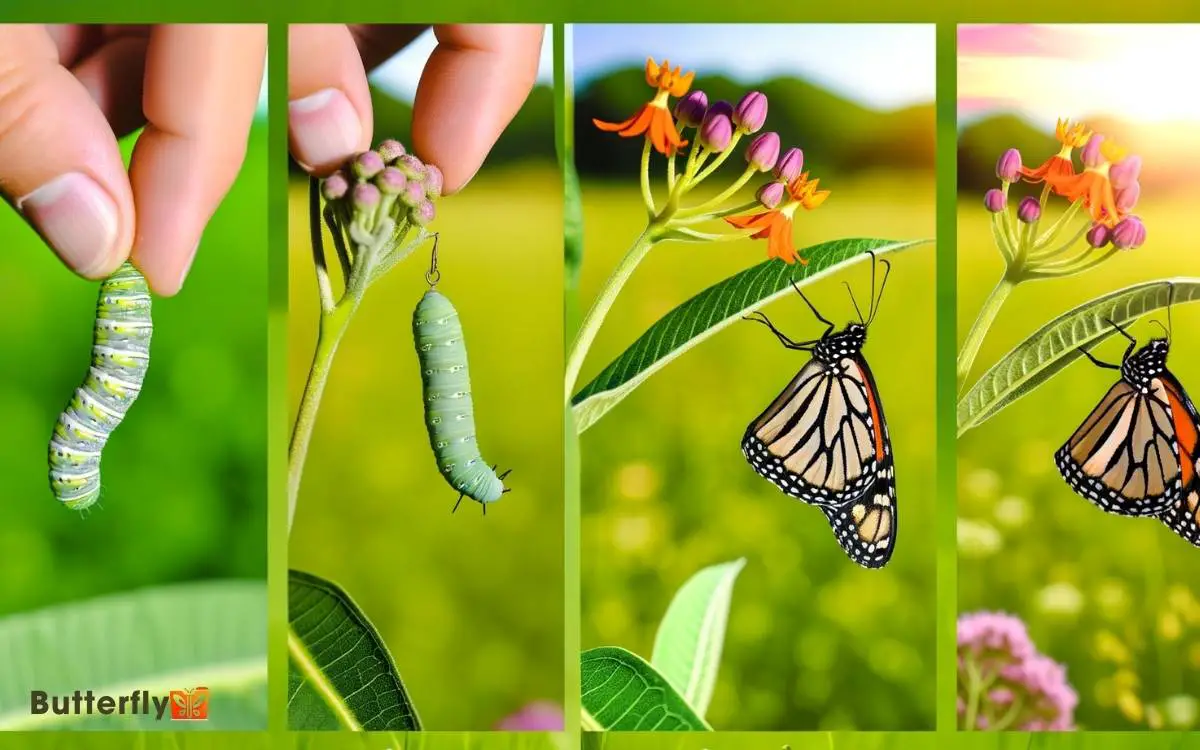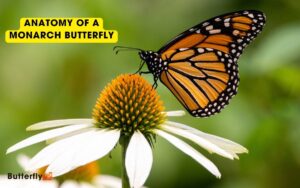How Long Do Monarch Butterfly Live? Get the Details!
Monarch butterflies’ lifespans vary by generation and environmental factors. Summer generations typically live 2-6 weeks, rapidly reproducing in warm temperatures.
In contrast, the Methuselah Generation, which emerges in late summer or early fall, can live up to 8-9 months. They enter a state called diapause, conserving energy with reduced metabolic rates and increased fat storage, allowing them to survive long migrations.
Factors like temperature, photoperiod, and nectar availability have a substantial impact on their survival and longevity.
Predators, habitat destruction, and climate change also threaten their existence. Understanding these dynamics can reveal surprising insights about their remarkable life cycle.

Key Takeaways
Monarch Butterfly Life Cycle
The monarch butterfly’s life cycle consists of four distinct stages: egg, larva (caterpillar), pupa (chrysalis), and adult. You’ll find that each stage is meticulously timed and vital for development.
Starting as a tiny egg, typically laid on milkweed plants, it hatches within 3-5 days. The larva then consumes the milkweed, undergoing five instars (growth stages) over about two weeks.
Next, it forms a chrysalis, where metamorphosis occurs. Over 10-14 days, the caterpillar’s body reorganizes into an adult butterfly.
Emerging from the chrysalis, the adult initially has soft wings that harden within hours. This life cycle, which spans roughly 30 days, exemplifies nature’s intricate processes, ensuring the monarch’s survival and migration capabilities.
Summer Generations
During the summer months, monarch butterflies go through rapid reproductive cycles, producing multiple generations that contribute to population growth.
Each generation typically lives for 2-6 weeks, focused on mating and laying eggs. You’ll find that the warmer temperatures accelerate their development through four stages: egg, larva, pupa, and adult.
Here’s a quick look at their summer generational timeline:
| Stage | Duration | Key Activities |
|---|---|---|
| Egg | 3-5 days | Hatching |
| Larva | 10-14 days | Feeding, growing |
| Pupa | 10-14 days | Transformation |
| Adult | 2-6 weeks | Mating, laying eggs |
This rapid cycle ensures that several generations propagate during the summer, boosting monarch numbers significantly. Understanding these stages helps you appreciate their complex lifecycle and ecological importance.
Methuselah Generation
Unlike their summer counterparts, the Methuselah Generation of monarch butterflies, named after the biblical figure known for his longevity, can live up to 8-9 months, allowing them to migrate across vast distances.
This remarkable lifespan results from diapause, a state of suspended development triggered by shorter daylight hours and cooler temperatures.
You’ll find that these butterflies conserve energy by reducing metabolic rates, which delays reproduction. As a consequence, they can travel from North America to overwintering sites in Mexico.
Scientific research indicates that the Methuselah Generation undergoes physiological changes, such as increased fat storage and altered hormone levels, to endure this long journey.
Understanding these adaptations helps you appreciate the extraordinary survival strategies of these monarchs.
Environmental Factors
Environmental factors play a pivotal role in shaping the lifecycle and migratory patterns of the Methuselah Generation of monarch butterflies, influencing their survival and reproductive success.
You’ll find that temperature, photoperiod (day length), and availability of nectar sources are important. These elements directly affect their metabolic rates, flight endurance, and timing of reproductive cycles.
Consider the following factors:
- Temperature fluctuations: Affects flight ability and energy conservation.
- Photoperiod changes: Triggers migratory and reproductive behaviors.
- Nectar availability: Provides essential energy for migration and survival.
- Habitat quality: Ensures safe roosting and breeding grounds.
Understanding these factors helps explain why monarchs migrate thousands of miles and how they time their lifecycle events precisely.
Predators and Threats
Facing a myriad of predators and threats, monarch butterflies often fall victim to natural enemies such as birds, spiders, and ants, alongside anthropogenic dangers like habitat destruction and pesticide use.
Birds, particularly the black-headed grosbeak, prey on monarchs despite their toxic cardenolides. Spiders and ants also pose significant predation risks during the larval and pupal stages.
Habitat destruction, especially deforestation in overwintering sites, severely limits their breeding grounds. Pesticide use in agricultural areas can decimate milkweed populations, the sole food source for monarch larvae.
Additionally, climate change exacerbates these threats by altering migration patterns and overwintering site conditions. You must understand these multifaceted threats to grasp the precarious nature of monarch butterfly survival.
Conservation Efforts
Conservation efforts focus on habitat restoration, including planting milkweed and nectar plants, to support monarch butterfly populations. Milkweed serves as the sole host plant for monarch larvae, while nectar plants provide essential energy for adult butterflies.
You can make a significant impact by engaging in these activities:
- Plant native milkweed species: Monarchs need specific types adapted to their regional environment.
- Create pollinator gardens: Include a variety of nectar-rich plants to sustain butterflies throughout their lifecycle.
- Avoid pesticides: Chemicals can be detrimental to both larvae and adult butterflies.
- Support conservation organizations: Donations and volunteer work can bolster large-scale habitat restoration projects.
These scientifically-backed efforts help mitigate the decline in monarch populations, ensuring their survival and ecological role.
Conclusion
You’ve now journeyed through the monarch butterfly’s life cycle, from summer generations to the Methuselah generation.
Remember, environmental factors and predators pose significant threats. Yet, don’t lose hope—conservation efforts are in full swing.
Like a time-traveling DeLorean, your actions today can impact these butterflies’ future. By safeguarding habitats and reducing pesticide use, you’re giving monarchs a fighting chance.
So, let’s get to work and guarantee these magnificent creatures continue to grace our skies.







Hi there! I just wanged to ask if you evr have any problems with hackers?
My last blog (wordpress) was hacked and I ended uup losing several weeks of hard work due
to nno backup. Do you have any solutions to protect against hackers? http://boyarka-Inform.com/